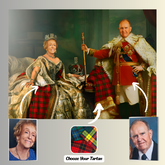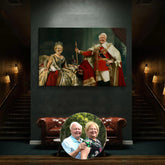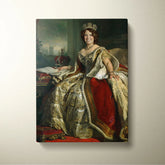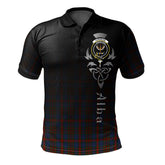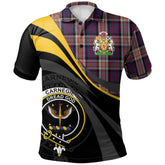-
Clan Carnegie Ancient Tartan Polo Shirt - Lion Rampant And Celtic Thistle Style TW75 - Carnegie Ancient Tartan
Clan Carnegie Ancient Tartan Polo Shirt - Lion Rampant And Celtic Thistle Style TW75 Description: Crafted in 100% polyester with your own design which combines comfort and vogue. This shirt has some'great features, it has 3 buttons, elastic collar and cuffs. 12.35 Oz. Made...- $38.25
- $38.25
- Unit price
- per
- Carnegie Ancient Tartan
-
Clan Carnegie Ancient Tartan Polo Shirt - Believe In Me Style ZS53 - Carnegie Ancient Tartan
Clan Carnegie Ancient Tartan Polo Shirt - Believe In Me Style ZS53 Description: Crafted in 100% polyester with your own design which combines comfort and vogue. This shirt has some'great features, it has 3 buttons, elastic collar and cuffs. 12.35 Oz. Made from polyester...- $38.25
- $38.25
- Unit price
- per
- Carnegie Ancient Tartan
-
Clan Carnegie Ancient Tartan Polo Shirt - Alba Celtic Style LG35 - Carnegie Ancient Tartan
Clan Carnegie Ancient Tartan Polo Shirt - Alba Celtic Style LG35 Description: Crafted in 100% polyester with your own design which combines comfort and vogue. This shirt has some'great features, it has 3 buttons, elastic collar and cuffs. 12.35 Oz. Made from polyester fabric....- $38.25
- $38.25
- Unit price
- per
- Carnegie Ancient Tartan
-
Clan Carnegie Ancient Tartan Polo Shirt KU63 - Carnegie Ancient Tartan
Clan Carnegie Ancient Tartan Polo Shirt KU63 Description: Crafted in 100% polyester with your own design which combines comfort and vogue. This shirt has some'great features, it has 3 buttons, elastic collar and cuffs. 12.35 Oz. Made from polyester fabric. 3 buttons, elastic collar...- $38.25
- $38.25
- Unit price
- per
- Carnegie Ancient Tartan
-
Clan Carnegie Ancient Clan - Military Polo Shirt IC31 - Carnegie Ancient Tartan
Clan Carnegie Ancient Clan - Military Polo Shirt IC31 Description: Crafted in 100% polyester with your own design which combines comfort and vogue. This shirt has some'great features, it has 3 buttons, elastic collar and cuffs. 12.35 Oz. Made from polyester fabric. 3 buttons,...- $38.25
- $38.25
- Unit price
- per
- Carnegie Ancient Tartan
-
Clan Carnegie 02 Tartan Polo Shirt - Royal Coat Of Arms Style EZ18 - Carnegie 02 Tartan
Clan Carnegie 02 Tartan Polo Shirt - Royal Coat Of Arms Style EZ18 Description: Crafted in 100% polyester with your own design which combines comfort and vogue. This shirt has some'great features, it has 3 buttons, elastic collar and cuffs. 12.35 Oz. Made from...- $38.25
- $38.25
- Unit price
- per
- Carnegie 02 Tartan
-
Clan Carnegie 02 Tartan Polo Shirt - Alba Celtic Style JO74 - Carnegie 02 Tartan
Clan Carnegie 02 Tartan Polo Shirt - Alba Celtic Style JO74 Description: Crafted in 100% polyester with your own design which combines comfort and vogue. This shirt has some'great features, it has 3 buttons, elastic collar and cuffs. 12.35 Oz. Made from polyester fabric....- $38.25
- $38.25
- Unit price
- per
- Carnegie 02 Tartan
-
Clan Carnegie 02 Tartan Polo Shirt PF52 - Carnegie 02 Tartan
Clan Carnegie 02 Tartan Polo Shirt PF52 Description: Crafted in 100% polyester with your own design which combines comfort and vogue. This shirt has some'great features, it has 3 buttons, elastic collar and cuffs. 12.35 Oz. Made from polyester fabric. 3 buttons, elastic collar...- $38.25
- $38.25
- Unit price
- per
- Carnegie 02 Tartan
-
Clan Carnegie 01 Tartan Polo Shirt - Royal Coat Of Arms Style IU49 - Carnegie 01 Tartan
Clan Carnegie 01 Tartan Polo Shirt - Royal Coat Of Arms Style IU49 Description: Crafted in 100% polyester with your own design which combines comfort and vogue. This shirt has some'great features, it has 3 buttons, elastic collar and cuffs. 12.35 Oz. Made from...- $38.25
- $38.25
- Unit price
- per
- Carnegie 01 Tartan
-
Clan Carnegie 01 Tartan Polo Shirt - Alba Celtic Style TA16 - Carnegie 01 Tartan
Clan Carnegie 01 Tartan Polo Shirt - Alba Celtic Style TA16 Description: Crafted in 100% polyester with your own design which combines comfort and vogue. This shirt has some'great features, it has 3 buttons, elastic collar and cuffs. 12.35 Oz. Made from polyester fabric....- $38.25
- $38.25
- Unit price
- per
- Carnegie 01 Tartan
-
Clan Carnegie 01 Tartan Polo Shirt EN89 - Carnegie 01 Tartan
Clan Carnegie 01 Tartan Polo Shirt EN89 Description: Crafted in 100% polyester with your own design which combines comfort and vogue. This shirt has some'great features, it has 3 buttons, elastic collar and cuffs. 12.35 Oz. Made from polyester fabric. 3 buttons, elastic collar...- $38.25
- $38.25
- Unit price
- per
- Carnegie 01 Tartan
-
Clan Carnegie Family Tartan 2D T-shirt LV48 - Black
Carnegie Family Tartan Clan 2D T-shirt LV48 Product detail: This new 2D t-shirt features a relaxed fit for Men and Women, durable, breathable and soft Made from 100% cotton The High-resolution graphic artwork is printed on the entire shirt. Machine wash cold. The print...- $29.25
- $29.25
- Unit price
- per
- Black
- White
- Navy
- Storm Grey
-
Carnegie Modern Tartan Clan Crest Badge Aloha Hawaiian Shirt Tropical Old Style WM97 - Carnegie Modern Tartan
Carnegie Modern Tartan Clan Crest Badge Aloha Hawaiian Shirt Tropical Old Style WM97 These Hawaiian shirts and shorts are suitable for hot summer days or beach trips with your friends, family, and loved ones. This is an excellent gift, vacation outfit, or simply revamp...- $43.25
- $43.25
- Unit price
- per
- Carnegie Modern Tartan
-
Carnegie Weathered Tartan Clan Crest Badge Aloha Hawaiian Shirt Tropical Old Style EM17 - Carnegie Weathered Tartan
Carnegie Weathered Tartan Clan Crest Badge Aloha Hawaiian Shirt Tropical Old Style EM17 These Hawaiian shirts and shorts are suitable for hot summer days or beach trips with your friends, family, and loved ones. This is an excellent gift, vacation outfit, or simply revamp...- $43.25
- $43.25
- Unit price
- per
- Carnegie Weathered Tartan
-
Carnegie Ancient Tartan Clan Crest Badge Aloha Hawaiian Shirt Tropical Old Style IB45 - Carnegie Ancient Tartan
Carnegie Ancient Tartan Clan Crest Badge Aloha Hawaiian Shirt Tropical Old Style IB45 These Hawaiian shirts and shorts are suitable for hot summer days or beach trips with your friends, family, and loved ones. This is an excellent gift, vacation outfit, or simply revamp...- $43.25
- $43.25
- Unit price
- per
- Carnegie Ancient Tartan
-
Clan Carnegie Ancient Crest Tartan Christmas Ugly Sweater AR14 - Carnegie Ancient Crest Tartan
Clan Carnegie Ancient Crest Tartan Christmas Ugly Sweater AR14 SIZE CHART- From $64.25
- From $64.25
- Unit price
- per
- Carnegie Ancient Crest Tartan
-
Clan Carnegie Modern Crest Tartan Christmas Ugly Sweater WU90 - Carnegie Modern Crest Tartan
Clan Carnegie Modern Crest Tartan Christmas Ugly Sweater WU90 SIZE CHART- From $64.25
- From $64.25
- Unit price
- per
- Carnegie Modern Crest Tartan
-
Clan Carnegie Ancient Tartan Christmas Ugly Sweater ZJ48 - Carnegie Ancient Tartan
Clan Carnegie Ancient Tartan Christmas Ugly Sweater ZJ48 SIZE CHART- From $64.25
- From $64.25
- Unit price
- per
- Carnegie Ancient Tartan
-
Clan Carnegie Modern Tartan Christmas Ugly Sweater XG91 - Carnegie Modern Tartan
Clan Carnegie Modern Tartan Christmas Ugly Sweater XG91 SIZE CHART- From $64.25
- From $64.25
- Unit price
- per
- Carnegie Modern Tartan
-
Clan Carnegie Modern "Merry Christmas" Tartan Acrylic Ornament AV65 - Carnegie Modern Tartan
Clan Carnegie Modern 'Merry Christmas' Tartan Acrylic Ornament AV65 “Decorating the house” may be one of the most exciting tasks jotted down on your to-do list when the holiday season approaches. Yet, since shabby, dull-looking pieces of decor infest the marketplace, finding real gems...- From $21.25
- From $21.25
- Unit price
- per
- Carnegie Modern Tartan
Ex: Your Tartan + Product
Popular Products
Turn Me Royal Personalized Portrait from Your Photo, Custom Tartan. Custom Canvas Wall Art as Gift for Men
- From $32.45
- From $32.45
- Unit price
- / per
Royalty Couple Personalized Portrait from Your Photo, Custom Tartan. Custom Canvas Wall Art
- From $47.45
- From $47.45
- Unit price
- / per
The Queen Personalized Portrait from Your Photo, Custom Tartan. Custom Canvas Wall Art as Gift for Women
- From $32.45
- From $32.45
- Unit price
- / per
List Of Tartan
-
Clan A
- Abercrombie Tartan
- Aberdeen Tartan
- Abernethy Tartan
- Adair Tartan
- Adam Tartan
- Ayrshire Tartan
- Agnew Tartan
- Aikenhead Tartan
- Ainslie Tartan
- Aiton Tartan
- Allan Tartan
- Alexander Tartan
- Allardice Tartan
- Allison Tartan
- Anderson Tartan
- Angus Tartan
- Anstruther Tartan
- Arbuthnot Tartan
- Armstrong Tartan
- Arnott Tartan
- Auchinleck Tartan
- Ayrshire Tartan
-
Clan B
- Baillie Tartan
- Bain Tartan
- Baird Tartan
- Balfour Tartan
- Bannatyne Tartan
- Bannerman Tartan
- Barclay Tartan
- Baxter Tartan
- Beaton Tartan
- Bell Tartan
- Belshes Tartan
- Bethune Tartan
- Beveridge Tartan
- Binning Tartan
- Bisset Tartan
- Blackadder Tartan
- Blackstock Tartan
- Black Watch Tartan
- Blair Tartan
- Blane Tartan
- Blyth Tartan
- Borthwick Tartan
- Boswell Tartan
- Bowie Tartan
- Boyd Tartan
- Boyle Tartan
- Brisbane Tartan
- Brodie Tartan
- Brown/ Broun Tartan
- Bruce Tartan
- Buccleuch Tartan
- Buchan Tartan
- Buchanan Tartan
- Burnett Tartan
- Burns Tartan
- Butter Tartan
- Byres Tartan
-
Clan C
- Cairns Tartan
- Calder Tartan
- Callander Tartan
- Cameron Tartan
- Campbell Tartan
- Campbell of Breadalbane Tartan
- Campbell of Cawdor Tartan
- Carmichael Tartan
- Carnegie Tartan
- Carruthers Tartan
- Cathcart Tartan
- Chalmers Tartan
- Charteris Tartan
- Chattan Tartan
- Cheyne Tartan
- Chisholm Tartan
- Christie Tartan
- Clark Tartan
- Clelland Tartan
- Clephan Tartan
- Clergy Tartan
- Cochrane Tartan
- Cockburn Tartan
- Colquhoun Tartan
- Colville Tartan
- Cooper Tartan
- Couper Tartan
- Craig Tartan
- Cranstoun Tartan
- Crawford Tartan
- Crichton Tartan
- Crief District Tartan
- Crosbie Tartan
- Cumming Tartan
- Cunningham Tartan
- Currie Tartan
- Clan D
- Clan E
- Clan F
- Clan G
- Clan H
- Clan I
- Clan J
- Clan K
- Clan L
-
Clan M
- Maitland Tartan
- Malcolm Tartan
- Mar Tartan
- Marjoribanks Tartan
- Maxtone Tartan
- Matheson Tartan
- Maule Tartan
- Maxwell Tartan
- Meldrum Tartan
- Melville Tartan
- Menzies Tartan
- Mercer Tartan
- Middleton Tartan
- Moffat Tartan
- Moncrieffe Tartan
- Montgomery Tartan
- Monypenny Tartan
- Moncreiffe Tartan
- Monteith Tartan
- Morrison Tartan
- Mouat Tartan
- Moubray Tartan
- Mow Tartan
- Muir_More Tartan
- Muirhead Tartan
- Munro Tartan
- Murray Tartan
- Murray of Atholl Tartan
-
Clan Mc/Mac
- MacAlister Tartan
- MacArthur Tartan
- MacAlpine Tartan
- MacAulay Tartan
- MacBain Tartan
- MacBean Tartan
- MacBeth Tartan
- MacCallum Tartan
- MacCraig Tartan
- MacColl Tartan
- MacCorquodale Tartan
- MacDiarmid Tartan
- MacDonald Tartan
- MacDonald of Clanranald Tartan
- MacDonald of Sleat Tartan
- MacDonnell of Glengarry Tartan
- MacDonnell of Keppoch Tartan
- MacDougall Tartan
- MacDowall Tartan
- MacDuff Tartan
- MacEwen_MacEwan Tartan
- MacEdward Tartan
- MacFarlane Tartan
- MacGill Tartan
- MacGillivray Tartan
- MacGregor Tartan
- MacGowan (McGowan) Tartan
- MacHardy Tartan
- MacIan Tartan
- MacInnes Tartan
- MacIntyre Tartan
- MacKay Tartan
- MacKillop Tartan
- MacKellar Tartan
- Mackinlay Tartan
- MacKenzie Tartan
- Mackie Tartan
- MacKinnon Tartan
- MacKintosh / MacIntosh Tartan
- MacLeod Tartan
- MacMillan Tartan
- MacNab Tartan
- MacNaughton Tartan
- MacNeil / MacNeill Tartan
- MacNeil of Colonsay Tartan
- MacNicol Tartan
- MacPhail Tartan
- MacPhee_MacFie Tartan
- MacPherson Tartan
- MacQuarrie Tartan
- MacQueen Tartan
- MacRae Tartan
- MacRow Tartan
- MacSporran Tartan
- MacTaggart Tartan
- MacTavish Tartan
- MacThomas Tartan
- McCorquodale Tartan
- McCulloch Tartan
- McFadzen Tartan
- McGeachie Tartan
- McIver Tartan
- McKerrell Tartan
- Clan N
- Clan O
- Clan P
- Clan R
-
Clan S
- Sandilands Tartan
- Scott Tartan
- Scrymgeour Tartan
- Selkirk Tartan
- Sempill Tartan
- Seton Tartan
- Shaw Tartan
- Shepherd Tartan
- Sinclair Tartan
- Skene Tartan
- Skirving Tartan
- Smith Tartan
- Somerville Tartan
- Spalding Tartan
- Spens Tartan
- Spottiswood Tartan
- Stevenson Tartan
- Stewart Tartan
- Stewart of Appin Tartan
- Stirling Tartan
- Strachan Tartan
- Straiton Tartan
- Strange Tartan
- Strathclyde District Tartan
- Stuart of Bute Tartan
- Sutherland Tartan
- Swinton Tartan
- Clan T
- Clan U W Y
- Request Your Clan
Clan Carnegie (Carnegie Tartan)
1. About Clan Carnegie
2. Clan Carnegie History
The neighborhood in Carmyllie, Angus, gave rise to the name of the Carnegies. However, prior to adopting this name, the family was known by the Angus, Scotland-based place name of Balinhard.
Records from 1230 contain information about the Balinhards. Walter de Maule gave John of Balinhard the lands and barony of Carnegie in 1358.
As John the First of Carnegie, he lived until the year 1370. His successor, John Carnegie of that ilk, had a direct line of descent that continued until 1530.
A significant Carnegie line was established in this region after Duthac of Carnegie purchased a portion of Kinnaird's estates in 1409.
At Flodden in 1513, John of Kinnaird fought and lost his life. Robert, his son, was appointed a judge in 1547. At the Battle of Pinkie, he was captured.
In 1556, after his release, he received a knighthood and was appointed Scotland's envoy to France.
He was the first Carnegie to assert that his ancestors served as the cup bearers for the Scottish kings. The family crest, which features an old cup, pays homage to this royal position.
Sir David Carnegie, the eighth of Kinnaird, was created Lord Carnegie of Kinnaird in 1616. He received the title Earl of Southesk in 1633.
Because of his Royalist views, Cromwell put the second Earl James in prison. He studied magic in Padau, which is why he was referred to as the "Black Earl."
Sir James Carnegie of Pittarrow, a distinguished soldier, was descended from a younger son of the 1st Earl of Southesk.
This family line became the Baronets of Nova Scotia in 1663. Lord Southesk and Glengarry collaborated closely in the Jacobite Army during the Rising of 1715.
In those days, the Glengarry tartan was adapted into the Carnegie tartan. The fourth duke of Fife, David Carnegie, resides at Kinnaird Castle in Angus, which serves as the family seat today.
Kinnaird Castle, near Brechin, is home to the Earl of Southesk, the future chief of Clan Carnegie
3. Clan Carnegie Tartans
James Carnegie, 5th Earl of Southesk, who participated in the 1715 uprising, is supposed to have adopted the Carnegie tartan, which is a variation of the MacDonnell of Glengarry.
The only apparent distinction is that the Carnegie's white changes from Glengarry white to yellow. The passage of time might, however, have contributed to this small variation.
While "modern" refers to the employment of darker colors, "ancient" refers to the dye colours, which are typically lighter.
Y/4 G4 R4 G4 R4 G12 K12 R4 B12 R4 B4 R4 B/6 Threadcount
Carnegie Ancient
Carnegie Modern
4. Clan Carnegie Crest & Coats of Arms
4.1 Clan Carnegie Crest
Worn by all of the name and ancestry
4.2 Clan Carnegie Coats of Arms
Note on Coats of Arms: A coat of arms is given to an individual under Scottish heraldic law (with the exception of civic or corporate arms). A 'family coat of arms' does not exist.
With the exclusions listed above, the weapons depicted below are personal weapons. The only person authorized to use these weapons is the grantee.
CARNEGIE, Earl of Southesk
An eagle exhibited on argent, beaked and membered in azure, and holding a cup with an old cover on its breast. Or
5. Clan Carnegie Places & People
5.1 Clan Carnegie People
Andrew Carnegie (1835-1919)
The most well-known industrialist and philanthropist in America called his Dunfermline birthplace "the most sacred spot to me on Earth."
He started working the bobbins at a fabric mill when he was a teenager and continued until he escaped to work as a telegraph messenger in 1850.
His family had to immigrate from Scotland to Pittsburgh because of unemployment in 1848.
He learned everything he could about business, and he took out a mortgage on his home to acquire shares that a boss had suggested.
We might not be aware of him right now if the shares had dropped. However, as his wealth grew, he focused his investments on sectors critical to America's development.
He was aware of the significance and requirements of the developing railroads because he had experience working for the Pennsylvania Railroad Company.
He was actively involved in the production of steel, sleeper cars, and locomotives.
The newly formed United States Steel Corporation, which sought to combine America's steel manufacturing, approached him in 1901.
He gave their representative Charles M. Schwab a piece of paper with his asking price for Carnagie Steel on it.
Schwab agreed, and Carnegie subsequently remarked that he ought to have requested an additional $100 million. Despite the fact that the number on the page read $400,000,000, he was informed "You'd have gotten" it.
In his "Gospel of Wealth," Carnegie asserted that "the man who dies rich, dies disgraced," and he spent his retirement giving away his riches.
While working at the Pittsburgh Telegraph Office, he recalled how Colonel James Anderson's free access to the library had considerably aided him.
Colonel Anderson is credited with spending an estimated £70.95 million on charitable endeavors, which included 2,811 libraries "for the masses."
One such example is the stunning, copper-domed structure that will house Glasgow's growing Mitchell Library, whose foundation stone was set by the man himself.
6. Associated Names
Carnegie of Southesk and Carnegie of Northesk are the branches.
- Choosing a selection results in a full page refresh.



